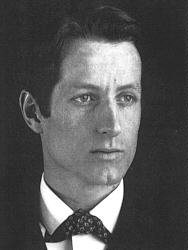
|
Maxfield Parrish was one of America's most beloved artists working during the "Golden Age of American Illustration." He achieved incredible artistic renown and critical acclaim during his lifetime and has continued to interest new audiences ever since. His prolific body of work has been reproduced in books, calendars, art prints, advertisements, and magazines for generations. His paintings and murals always utilized a unique juxtaposition of designed elements, luminescent colors, photorealistic subjects and romantic images which combined to captivate his viewers.
Maxfield Parrish so dominated the images America loved that in the 1920's one out of four homes had his world of make-believe hanging on their walls. In a survey taken in 1925, van Gogh, Cezanne and Parrish were thought to be the three greatest artists of all time. Consequently, Maxfield Parrish was the single most popular American artist of the early decades of the 20th century. The continuing demand for his art prints today indicates America's fondness for his fantasy images.
The physically striking Maxfield Parrish was Frederick Parrish, the son of the noted etcher Stephen Parrish and Elizabeth Bancroft Parrish. Parrish's early years were filled with privilege and education. His father was not only an inspiration to him as an artist, but he also exposed the precocious lad to European museums and to classical art. Frederick (later Parrish adopted his maternal grandmother's maiden name as his Christian name), was particularly drawn to such contemporary English artists as the Pre-Raphaelites, Rossetti, and Lord Leighton. Parrish took an immediate interest in Leighton's art, his lifestyle, and theshaped Parrish's artistic vision, and most certainly contributed to the creation of his curious blend of naturalism, fantasy and romanticism.
After a brief and belabored period of studying architecture at Haverford College, Parrish dropped out to study painting full time. Soon, he had painted his first serious work, 'Moonrise', while he was living with his father at a Gloucester, Massachusetts artist colony. Simultaneously he enrolled at the Pennsylvania Academy of Fine Art. While at the Academy, Parrish became familiar with the work of Howard Pyle and audited Pyle's first classes in illustration at Drexel Institute. Parrish quickly realized that the use of historic subject matter captured the sentiments of the print audience, and he decided upon his career choice. There was a great demand for talented illustrators as magazines proliferated.
Another influential force in Parrish's academic career were the theories advanced by the historian-illustrator, Jay Hambidge, who preached in a series of lectures at Yale about a composition style which he called "dynamic symmetry." This system offered artists a formula for reproducing natural proportions in their works. It gave Parrish a taste for the symmetry that was to later become such a major part of his art. In fact, almost every one of his works is based upon this technique. It became a system for him; first he did montage layouts which he would then paint. The final execution was almost etching-like, precisely articulated with romantic images emanating from his incredibly fertile imagination. The colors appearing in Parrish's works were so bold that even today cobalt blue is still referred to as "Parrish blue." These images will stand forever, unique and strong blending into a fantasy world never witnessed before or since.
After painting the mural of 'Old King Cole' in 1895 for the Mask and Wig Club, a thespian society at the University of Pennsylvania, Parrish's work began to be exhibited and published, and ultimately he became the center of attention nationally. By the age of 25, Parrish was commissioned to paint his first magazine cover for Harper's Bazaar. Following quickly on the heels of that success, Parrish was inducted into the Society of American Artists in 1897, based on the brilliance of his seminal painting, The Sandman.
In successive years Maxfield Parrish garnered major commissions for many national magazines and books, including a yearly calendar contract with Edison Mazda (General Electric). His success attracted a group of fellow artists and also admirers of his estate, called "The Oaks," near Cornish, at Plainfield, New Hampshire. He personally designed and built much of the building complex by himself with the help of a local carpenter. By the 1900's there were many artists and intellectuals in full-time residence at Cornish. The area had become an artist colony in its own right and even attracted President Woodrow Wilson to reside there during the summers.
In the years from 1904 to 1935 Parrish was never at a loss for work. His fame grew and his commissions soared up to $2,000 per illustration. This was a time when illustrators were celebrities. In 1922 Parrish completed a painting that was a pinnacle for him in many ways. This painting entitled 'Daybreak' features his daughter Jean, an artist in her own right, and Kitty Owen, the daughter of William Jennings Bryan. It was laid out with dynamic symmetry, embodied classical elements, and featured a mountainous "Parrishscape" in its background; in short, 'Daybreak' was quintessential Parrish. The ensuing art print of this painting is thought to be the most widely sold art print in history.
From 1931 onwards Parrish painted landscapes for a calendar series as well as for greeting cards and playing cards. In 1960 Parrish stopped painting altogether after Susan Lewin, his model and companion of 55 years, married at the age of 70. Maxfield Parrish quietly passed away at the age of 95 at "The Oaks" in 1966. He has lived to see his work continually recognized and revered by successive generations throughout the world.
|

